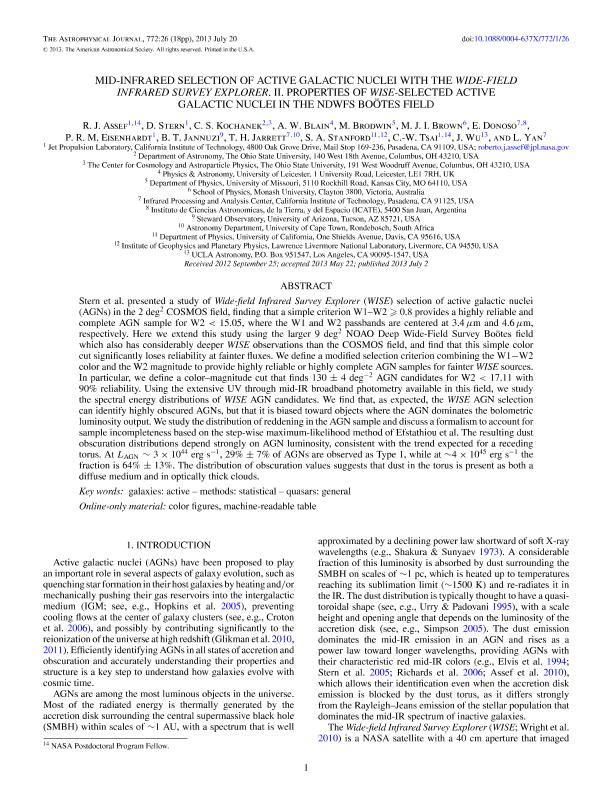Mostrar el registro sencillo del ítem
dc.contributor.author
Assef, R. J.
dc.contributor.author
Stern, D.
dc.contributor.author
Kochanek, C. S.
dc.contributor.author
Blain, A. W.
dc.contributor.author
Brodwin,
dc.contributor.author
Donoso, Emilio

dc.contributor.author
Eisenhardt, P.
dc.contributor.author
Jannuzi, B. T.
dc.contributor.author
Jarrett, T. H.
dc.contributor.author
Stanford, S. A.
dc.contributor.author
Tsai, C. W.
dc.contributor.author
Yan, L.
dc.date.available
2015-08-12T15:28:02Z
dc.date.issued
2013-07-02
dc.identifier.citation
Assef, R. J.; Stern, D.; Kochanek, C. S.; Blain, A. W.; Brodwin,; et al.; Mid-Infrared Selection of Active Galactic Nuclei with the Wide-Field Infrared Survey Explorer. II. Properties of WISE-Selected Active Galactic Nuclei in the NDWFS Boötes Field; American Astronomical Society; Astrophysical Journal; 772; 26; 2-7-2013; 1-18
dc.identifier.issn
0004-637X
dc.identifier.uri
http://hdl.handle.net/11336/1642
dc.description.abstract
Stern et al. presented a study of Wide-field Infrared Survey Explorer (WISE) selection of active galactic nuclei (AGNs) in the 2 deg^2 COSMOS field, finding that a simple criterion W1–W2 ≥ 0.8 provides a highly reliable and complete AGN sample for W2 < 15.05, where the W1 and W2 passbands are centered at 3.4 μm and 4.6 μm, respectively. Here we extend this study using the larger 9 deg2 NOAO Deep Wide-Field Survey Boötes field which also has considerably deeper WISE observations than the COSMOS field, and find that this simple color cut significantly loses reliability at fainter fluxes. We define a modified selection criterion combining the W1−W2 color and the W2 magnitude to provide highly reliable or highly complete AGN samples for fainter WISE sources. In particular, we define a color–magnitude cut that finds 130 ± 4 deg^−2 AGN candidates for W2 < 17.11 with 90% reliability. Using the extensive UV through mid-IR broadband photometry available in this field, we study the spectral energy distributions of WISE AGN candidates. We find that, as expected, the WISE AGN selection can identify highly obscured AGNs, but that it is biased toward objects where the AGN dominates the bolometric luminosity output. We study the distribution of reddening in the AGN sample and discuss a formalism to account for sample incompleteness based on the step-wise maximum-likelihood method of Efstathiou et al. The resulting dust obscuration distributions depend strongly on AGN luminosity, consistent with the trend expected for a receding torus. At LAGN ~ 3 × 10^44 erg s^−1, 29% ± 7% of AGNs are observed as Type 1, while at ~4 × 10^45 erg s^−1 the fraction is 64% ± 13%. The distribution of obscuration values suggests that dust in the torus is present as both a diffuse medium and in optically thick clouds.
dc.format
application/pdf
dc.language.iso
eng
dc.publisher
American Astronomical Society

dc.rights
info:eu-repo/semantics/openAccess
dc.rights.uri
https://creativecommons.org/licenses/by-nc-sa/2.5/ar/
dc.subject
Galaxies
dc.subject
Statistical Methods
dc.subject
Quasars
dc.subject
Infrared
dc.subject
Wise
dc.subject
Galactic Nuclei
dc.subject.classification
Astronomía

dc.subject.classification
Ciencias Físicas

dc.subject.classification
CIENCIAS NATURALES Y EXACTAS

dc.title
Mid-Infrared Selection of Active Galactic Nuclei with the Wide-Field Infrared Survey Explorer. II. Properties of WISE-Selected Active Galactic Nuclei in the NDWFS Boötes Field
dc.type
info:eu-repo/semantics/article
dc.type
info:ar-repo/semantics/artículo
dc.type
info:eu-repo/semantics/publishedVersion
dc.date.updated
2016-03-30 10:35:44.97925-03
dc.journal.volume
772
dc.journal.number
26
dc.journal.pagination
1-18
dc.journal.pais
Estados Unidos

dc.journal.ciudad
Washington
dc.conicet.avisoEditorial
©2013. The American Astronomical Society. All rights reserved.
dc.description.fil
Fil: Assef, R. J.. No especifíca;
dc.description.fil
Fil: Stern, D.. No especifíca;
dc.description.fil
Fil: Kochanek, C. S.. Ohio State University; Estados Unidos
dc.description.fil
Fil: Blain, A. W.. University of Leicester; Reino Unido
dc.description.fil
Fil: Brodwin,. University of Missouri; Estados Unidos
dc.description.fil
Fil: Donoso, Emilio. Consejo Nacional de Investigaciones Científicas y Técnicas. Centro Cientifico Tecnológico - CONICET - San Juan. Instituto de Ciencias Astronómicas de la Tierra y del Espacio; Argentina
dc.description.fil
Fil: Eisenhardt, P.. No especifíca;
dc.description.fil
Fil: Jannuzi, B. T.. Arizona State University; Estados Unidos
dc.description.fil
Fil: Jarrett, T. H.. University of Cape Town; Sudáfrica
dc.description.fil
Fil: Stanford, S. A.. University of California; Estados Unidos
dc.description.fil
Fil: Tsai, C. W.. No especifíca;
dc.description.fil
Fil: Yan, L.. No especifíca;
dc.journal.title
Astrophysical Journal

dc.relation.alternativeid
info:eu-repo/semantics/altIdentifier/doi/http://dx.doi.org/doi:10.1088/0004-637X/772/1/26
dc.relation.alternativeid
info:eu-repo/semantics/altIdentifier/url/http://iopscience.iop.org/0004-637X/772/1/26
dc.relation.alternativeid
info:eu-repo/semantics/altIdentifier/url/http://arxiv.org/abs/1209.6055v3
Archivos asociados
